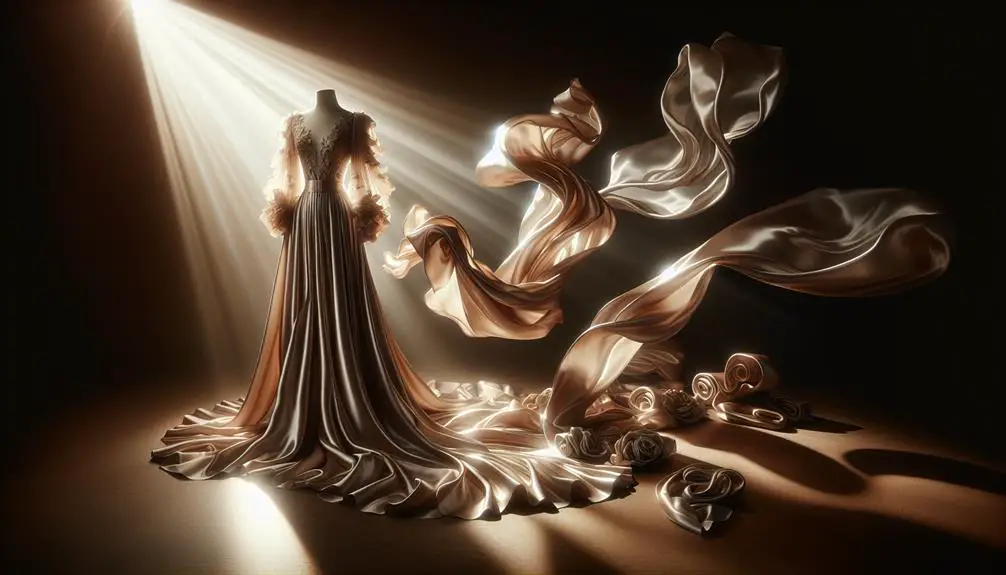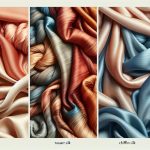When it comes to silk, two popular examples are Mulberry Silk and Eri Silk. Mulberry Silk is widely used and known for its quality. It's crafted from silkworms raised specifically for silk production. Eri Silk, also called peace silk, is sourced ethically from eri silkworms feeding on castor leaves. Both offer unique properties and are favored in different applications. Want to learn more about these fascinating silks and how they compare?
Table of Contents
Key Takeaways
- Mulberry Silk: Derived from Bombyx mori silkworm, known for luxury fashion, vibrant dyeing, and hypoallergenic properties.
- Eri Silk: Originates from India, produced by eri silkworms, eco-friendly with wool-like feel, used for sarees and blankets.
- Mulberry silk: Delicate appearance, natural sheen, popular for fine garments.
- Eri silk: Durable, thermal properties, ethical (peace silk), favored for cold-weather clothing.
- Eri silk production: Environmentally friendly, non-lethal, sustainable, ideal for cozy textiles.
Mulberry Silk Overview
Mulberry silk, renowned for its delicate appearance and natural sheen, dominates the global silk production scene, accounting for a staggering 90% of the silk market. This luxurious silk is derived from the cocoons of the mulberry silkworm, scientifically known as Bombyx mori. The mulberry silkworm is carefully nurtured in captivity to guarantee the production of high-quality silk with consistent properties, making it a preferred choice for textile production.
One of the remarkable aspects of mulberry silk is its versatility in creating a variety of luxurious fabrics such as dupioni, satin, and chiffon. Designers favor mulberry silk due to its high quality, which has solidified its status as a staple in the fashion industry. Its natural sheen and smooth texture set it apart from other types of silk, making it a popular option for crafting elegant and refined garments and textiles. With its unique characteristics and superior quality, mulberry silk continues to be a coveted choice for creating exquisite fabrics.
Mulberry Silk Characteristics
Renowned for its luxurious feel and high-quality fabric, mulberry silk boasts a range of exceptional characteristics that set it apart in the textile industry. Accounting for a staggering 90% of global silk production, this silk is derived from the cocoons of the Bombyx mori silkworm, a process that results in a delicate appearance and natural sheen.
What makes mulberry silk truly stand out is its versatility; it can be found in various fabrics like dupioni, satin, and chiffon. This silk isn't just about looks; it also offers health benefits. Mulberry silk is known for its temperature regulation properties and hypoallergenic nature, making it a sought-after choice for those with sensitive skin.
Additionally, its fine texture, strength, and vibrant dyeing capabilities make it a top pick for designers looking to create stunning pieces in a wide array of colors.
Mulberry Silk Applications
Mulberry silk has some fascinating uses that are worth exploring.
This type of silk offers numerous benefits due to its exceptional properties.
Let's take a closer look at how Mulberry silk is produced and the specific qualities that make it stand out in various applications.
Mulberry Silk Benefits
Known for its delicate appearance, natural sheen, and versatility in various designs, mulberry silk offers a range of benefits that make it a popular choice for luxurious clothing items like dupioni, satin, and chiffon. Mulberry silk stands out due to its high quality and luxurious properties, making it a top pick for designers worldwide.
The health benefits of mulberry silk are notable, including its ability to regulate temperature and its hypoallergenic properties. This silk fabric isn't only aesthetically pleasing but also provides comfort and care for the wearer.
Whether used in elegant evening gowns or sophisticated blouses, mulberry silk continues to be a symbol of refinement in the world of fashion.
Mulberry Silk Production
When exploring the world of silk production, one can't help but marvel at the intricate process behind creating luxurious mulberry silk fabrics. Mulberry silk, derived from the cocoons of Bombyx mori silkworms, is a cornerstone of the global silk industry, constituting 90% of silk production worldwide.
Its delicate appearance and natural sheen make it highly sought after for luxury apparel such as dupioni, satin, and chiffon fabrics. The versatility of mulberry silk allows it to be crafted into a range of textiles, each embodying a touch of elegance and sophistication.
Originating in China, mulberry silk production has expanded to various regions, solidifying its position as a significant player in the silk industry on a global scale.
Mulberry Silk Properties
With its reputation for elegance and versatility, mulberry silk finds itself adorning a myriad of luxurious items in the fashion industry. This luxurious silk fabric is highly sought after by designers for its natural sheen and the ability to create a wide range of designs.
Some of the key applications of mulberry silk include:
- Luxurious dresses that drape beautifully and feel exquisite against the skin.
- Elegant blouses that showcase the natural sheen of mulberry silk in sophisticated designs.
- Delicate scarves and lingerie that benefit from the silk's hypoallergenic properties, making them gentle on the skin.
Mulberry silk not only adds a touch of luxury to fashion pieces but also offers health benefits like temperature regulation, making it a versatile and prized material.
Eri Silk Overview
Eri silk, also known as peace silk, originates from India and is renowned for its heavy and durable characteristics. This variety of silk is produced by the eri silkworm, which consumes castor leaves and is indigenous to India.
One noteworthy aspect of Eri silk is that it can be harvested without causing harm to the silkworm, making it a humane silk option. The fabric boasts a distinct texture and is frequently utilized for crafting cozy and long-lasting materials such as shawls and blankets.
Additionally, Eri silk is an environmentally friendly choice because the production process doesn't entail the killing of the silkworms.
Eri Silk Characteristics
Eri silk has some unique qualities that set it apart from other types of silk. Its heavy and durable nature makes it ideal for various textile uses.
Additionally, the production process of Eri silk contributes to its reputation as a sustainable and ethical choice in the textile industry.
Eri Silk Qualities
Known for their humane production process that allows silkworms to emerge unharmed from their cocoons, Eri silk possesses qualities that make it a popular choice for a variety of products.
- Eri silk is heavy and durable, making it ideal for products like shawls, scarves, and blankets.
- Eri silk has thermal properties, providing warmth in colder climates and breathability in warmer weather.
- Eri silk is eco-friendly as it doesn't require harmful chemicals in the production process.
Eri silk's unique texture, sustainability, and the fact that it's traditionally used in Assam, India, further add to its appeal for those looking for a combination of quality and ethical production methods.
Eri Silk Production
Moving from the exceptional qualities of Eri silk, let's explore the fascinating domain of Eri Silk Production and its defining characteristics. Eri silk, also known as peace silk, is produced by the eri silkworm, native to India, known for its sustainability. This silk is favored for its thermal properties, ideal for blending with other textiles. Eri silk fabric boasts a unique texture, adding a distinctive touch to various items. Its eco-friendly production process appeals to environmentally conscious consumers. Below is a table summarizing key characteristics of Eri silk:
| Characteristic | Description |
|---|---|
| Sustainability | Native eri silkworms make production eco-friendly |
| Thermal Properties | Ideal for blending due to excellent insulation |
| Unique Texture | Adds distinctiveness to clothing and decor |
| Durable | Known for its strength and longevity |
| Versatile | Suitable for various textile applications |
Eri Silk Applications
Have you ever wondered how Eri silk's thermal properties make it a versatile choice for blending with other materials in various applications?
Eri silk, with its unique characteristics, finds itself in a variety of uses:
- Blending: Eri silk's thermal properties make it an excellent candidate for blending with other fabrics, enhancing their overall quality and performance.
- Textiles: The wool-like feel of Eri silk makes it perfect for creating cozy textiles such as blankets and bed covers, adding a touch of luxury and warmth.
- Sarees: Traditionally, Eri silk is a popular choice for crafting sarees due to its textured appearance, durability, and elegant drape.
These applications demonstrate the adaptability and appeal of Eri silk in different contexts. Whether it's for enhancing fabric properties, creating comfortable textiles, or designing timeless garments like sarees, Eri silk's eco-friendly nature and sustainable production process further add to its allure.
Silk Comparison: Mulberry Vs. Eri
Comparing Mulberry silk and Eri silk reveals unique characteristics that cater to different preferences and needs in the textile industry. Mulberry silk, derived from the Bombyx mori silkworm, constitutes the majority of global silk production, known for its delicate appearance and natural sheen. On the other hand, Eri silk, sourced from the Philosamia ricini silkworm, offers distinct advantages such as durability, thermal properties, and a wool-like feel.
Ethical considerations also play a significant role in the silk comparison. Eri silk, often referred to as peace silk, is deemed more ethical as the silkworms are allowed to emerge from their cocoons naturally, unlike in mulberry silk production where the silkworms are typically boiled alive to obtain longer silk threads. This aspect of Eri silk production appeals to those seeking more sustainable and cruelty-free options in the textile industry.
In terms of applications, while Mulberry silk is favored for its luxurious appeal in fine garments and silk fabrics, Eri silk's resilience and warmth make it a preferred choice for heavier textiles and cold-weather clothing. Both silk types have their place in the market, offering consumers a range of options based on their priorities and values.
Frequently Asked Questions
What Are the Two Examples of Type of Silk?
When it comes to silk, there are two main types: Mulberry silk, known for its delicate appearance and sheen, and Tussar silk, which has a textured feel and is traditionally used for making sarees.
What Are 2 Uses of Silk?
Silk serves various purposes, from crafting elegant clothing to creating luxurious home decor. Its strength makes it ideal for producing parachutes and surgical sutures. The antibacterial properties and softness of silk set it apart from synthetic materials.
What Is an Example of a Silk Fabric?
When it comes to silk fabric, one great example is Charmeuse. Its softness, lustrous shine, and satin weave make it a favorite. Another lovely silk fabric is Chiffon, known for its sheer elegance and lightweight feel.
What Are Two Products Made From Silk?
Silk is a versatile fabric with various uses. It is found in apparel like scarves and lingerie. Its smooth texture makes it ideal for elegant eveningwear. In industries, silk is used for items such as parachutes and surgical sutures.
- Tetron Fabric for Marine Applications: Durability and Use Cases - June 18, 2025
- Tetron Fabric for Outdoor Furniture: Weather Resistance and Care - June 18, 2025
- Tetron Fabric for Wall Coverings: Style and Application Tips - June 18, 2025







